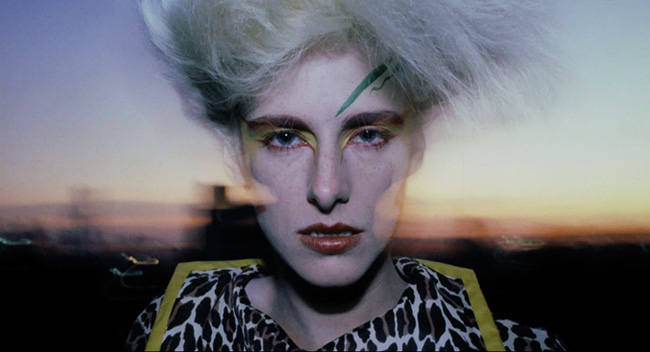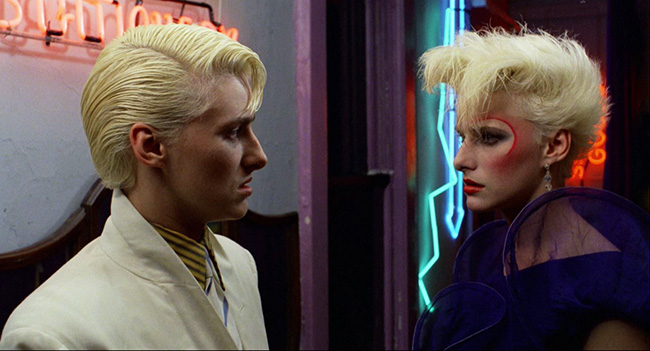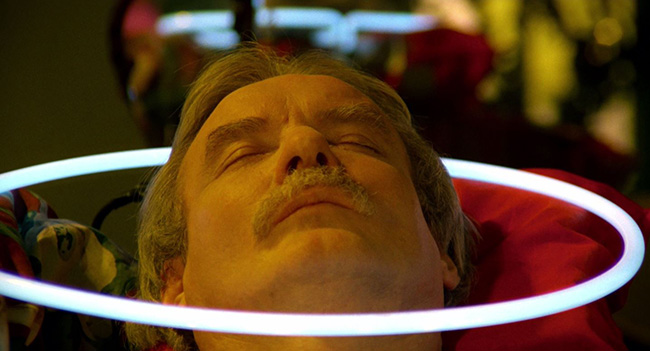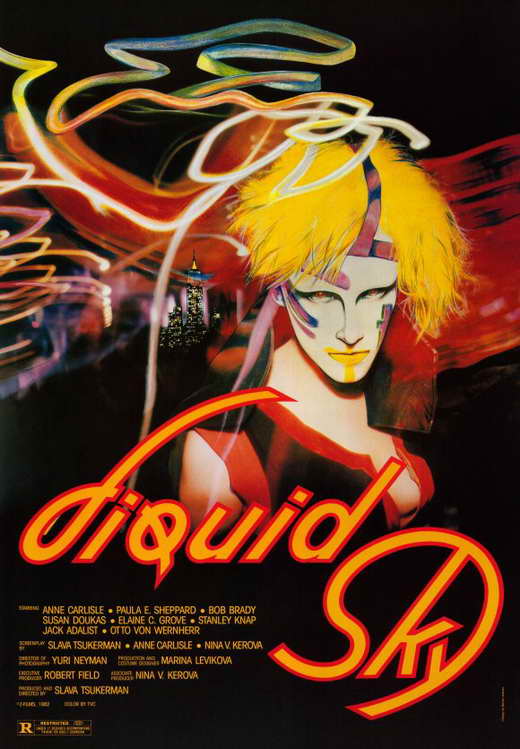
The flying saucer which appears early into Slava Tsukerman’s Liquid Sky (1982) is struck from the same mold as the UFO in Todd Haynes’ glam rock homage Velvet Goldmine (1998) or the one Steve Coogan encounters in Michael Winterbottom’s chronicle of the early 80’s Manchester scene, 24 Hour Party People (2002): it is a signal that the culture we are encountering is so anti-mainstream that it has one foot in the cosmic void. The culture, in this case, is the New Wave thriving in the grungy underground of 1982 New York City. Anne Carlisle, a young fashion model/artist/actress entrenched in this world of fashion and clubbing is the androgynous star, and she contributed to the screenplay alongside the Russian Tsukerman and his wife (and associate producer) Nina Kerova. Tsukerman has described it as a Cinderella fable in which the prince happens to be a shapeless alien being. The saucer itself appears to be massive when it first appears hovering near the Empire State Building, but we soon learn it’s a trick of perspective: when it settles onto a nearby rooftop it’s closer to the size of the spacecraft in *Batteries Not Included (1987). Although we get glimpses of the alien itself, an abstract visual collage reminiscent of an eyeball shooting lightning amidst swirling clouds of color, most close encounters are depicted from its point of view, solarized computer images of the apartment of Margaret (Carlisle) that the miniature alien has invaded. Feeding off endorphins, whenever an orgasm occurs it consumes the one who’s having it. This complicates Margaret’s sex life.

Petulant model Jimmy (Anne Carlisle) and Margaret (Carlisle again).
Margaret, in bleached blonde hair and colorful makeup like a Spider from Mars, is drifting at the outer edges of the fashion industry, albeit a small-scale one – a photographer shooting her works for something called “Midnight Magazine.” Despite the attention she attracts, she drifts in a state of isolation and loneliness. Her closest friend, a lover named Adrian (Paula E. Sheppard), also has an unpredictable and slightly predatory edge; her rival, a model named Jimmy – also played by Carlisle – tries to sabotage her when he’s not pursuing heroin. We watch as she takes one man home only to be raped by him. In this environment, the extraterrestrial becomes a welcome presence. At first her lovers are slain with a shard of glass through the scalp. After she (and Adrian) struggle to hide a body – eventually abandoning it in a cardboard box – the alien agrees to eliminate the evidence for her. Now the victims just crinkle up into tin foil and disappear. Meanwhile, a West German researcher (Otto Von Wernherr) tracking the UFO takes up in a woman’s apartment just to spy on Margaret and the saucer with a telescope from the window; she indulges his speeches about endorphin-absorbing aliens because she hopes to sleep with him. As Margaret begins to learn more of the alien’s methods, and as the bodies begin to pile up, she finds liberation; she also becomes the ultimate outsider, much more so than her fashion-conscious friends.

Professor Owen (Bob Brady), dead after orgasm.
The herky-jerky rhythm of Liquid Sky, its frank sex talk and drug use, and the idea of casting actors who are more or less playing their own clubbing selves lends the feel of a 60’s Andy Warhol underground film – unsurprising when you consider that prior to this, Tsukerman was planning to make a New York film with Warhol as his star. But a driving synthesizer score by Clive Smith, Brenda I. Hutchison, and Tsukerman, and the strong use of neon colors make the film far more striking, including an arresting series of shots where Carlisle, delivering a monologue about letting go of her mundane dreams and embracing her “David Bowie” androgyny, applies day-glo makeup in the dark – literally and symbolically creating her own face out of nothing. At almost two hours, Liquid Sky struggles with its pace, but stick with it. As the world begins to corner Margaret, and she begins to assert herself (backed by an alien guardian angel), the film’s feminist purpose takes on a compelling and hallucinatory vision. Margaret eventually melts into the saturated colors of the alien’s computerized POV before being sucked into the UFO’s tractor beam in the form of an image cast above the rooftop by a flickering film projector: the last we see of Margaret, she has become the midnight movie we’re watching. Liquid Sky was an inexplicable hit and received warm reviews; just as unexpected for a film that might as well be Pink Flamingos or El Topo, it was fairly easy to find in the 80’s at your local video store. Only in this century has the film become elusive, a situation remedied by Vinegar Syndrome’s gorgeous new Blu-ray presentation of a 4K restoration from the original 35mm negative. If you have seen Liquid Sky before, you have never seen it looking this spectacular. (Arguments that a grungy movie like this shouldn’t look this good immediately evaporate upon watching it. The cinematography by Yuri Neyman and the low-fi special effects are mesmerizing.) Vinegar Syndrome and Tsukerman pack the disc with special features, among them a retrospective documentary by Tsukerman, in which he sends Carlisle to some of the film’s locations, now torn down or devoured by gentrification (a club has become a pet store), though in one of the former spots she finds a mural depicting – a flying saucer.










